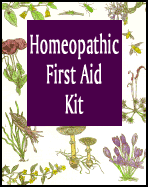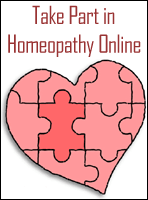ABBREVIATION: Acon.
COMMON NAME: Monk's hood, Wolfsbane
N.O.: Ranunculaceae.
DESCRIPTION: Perennial herb, with a perpendicular, tapering and tuberous root. The leaves are alternate, dark green in color. The stem is upright, 2 to 6 feet high, round, green and slightly hairy above, flower appear from May to July they are dark-violet in color, and helmet shaped i.e. they turn over and appear like a hood hence the name Moonkshood.
PART USED: Whole plant with roots, when begins to flower.
PROVED BY: Hahnemann published its pathogenesis in 1805.
CAUSATION: Aconite conditions are caused by exposure to the extreme of temperature and also from fright. Ailments which develop from of after fear, fright, vexation, chill, cold-dry winds, heat-especially of sun, injury, surgical operation and shock come with in its range.
ADAPTABILITY: Particularly adapted to full blooded young, robust persons. Plethoric young girls who lead a sedentary life. Usually indicated in the beginning of acute diseases; not indicated when pathological change have taken place. Kent says: Aconite is like a great storm, it comes, sweeps over and passes away. But sometimes cases of reat chronicity amenable to its action.
MARKED FEATURES: Suddenness, Intensity, Anxiety, Restlessness, Fear, Causation, Fright, Intense dry cold or heat. Dry hot skin, excessive sensibility, Ailments that appear suddenly with intensity and violence from exposure to dry cold winds or intense heat.
MENTAL: Anxiety, Restlessness, Fear, Irritability, Characterize the mental symptoms of Aconite. Typical aconite restlessness is accompanied by anxiety. It is anxious restlessness. Irritable vexed at trifles: Ailments from vexation. In their heightened conditions, anxiety and nervous irritation give place to fear, one of the most characteristic keynotes of the remedy. Uneasiness, worry or fear, accompanying a most trifling ailment, such as inflammation of the eyelids. Great and uncontrollable anguish, anxiety and great fear, are characteristic of the Aconite disease.
FEAR: Fear of death especially but fear to cross the street, fear to go into society or crowd, where there is excitement or any people, fears something is going to happen, fear of dark, indefinable, unreasonable fear. The face is expressive of fear. Predicts the expected day (even hour) of his death, this is very characteristic symptom. Unnatural fear, and fear of death during pregnancy. Effects from fright either immediate or remote.
Intense delirium with excitement and fear, patient will weep as a great torment. There is excitability, anger, throwing things away, all attended with violence and anxiety, does every thing in great haste. Anguish must change often, everything startles him.
Variable humor, gay, then dejected. Unsteadiness of ideas. Music is unbearable, makes patient sad.
HEAD: Violent headaches, headache from taking cold, from suppressing catarrh. Tearing burning in the brain. Congestion of the brain, with congestive headache, anxiety and hot face.
Pain in front part of head or frontal headache with fullness and heaviness as if an out pressing weight lay there and if all would be forced out at the forehead
SENSORIUM: Vertigo from congestion, after dry cold winds, or heat of sun, from anger and fright. Vertigo on raising the head, or fainting on rising from a recumbent position with paleness of face. Vertigo with, inclination to fell to right side.
EYES: Inflammatory affections of eyes caused by dust, or foreign body, mechanical
injury, or surgical operation. Bhaja states that Aconite is more important than Arnica in iritis caused by mechanical injury.
Eyes red and inflamed, with burning and sudden swelling. Heat and burning in the eyes with pressive and shooting pains. Intolerable. Red hard swelling of the lids, feel dry and heavy burning and sensitiveness to air, cold water relieves the dry heat swelling without any discharge, or profuse lachrymation -- hot watery ,mucus. Sudden attacks of blindness.
EAR: Sudden, intense, inflammation of the ear - after exposure to dry cold winds. Great sensibility of olfactory nerves, all noise is intolerable; music unbearable make her sad. External ear hot, swollen and red. Throbbing intense cutting pains in the ear.
NOSE: Coryza with violent headache. sneezing, fever, thirst, and restlessness after exposure to cold. Violent headache, after Coryza has been suppressed by exposure. Nosebleed - bright red haemorrhage.
FACE: Anxiety expression frightened, fear of death prevails on face. Face bloated, hot and red, but assumes paleness on rising. Neuralgic pains in the face, like hot wires, or crawling and creeping like ants -- with or without pain. Intense heat of face, with sweat on the side of the face laid on.
TEETH: Violent toothache, from exposure to dry cold wind, intense cutting, shooting pains in hollow teeth. Toothache in sound teeth. Convulsion of teething children, twitching of single muscles.
MOUTHS: Bitter taste of every thing except water. Dryness of mouth and tongue. Tongue coated white. Thirst for large quantities of cold water and Kent says "it agrees well".
THROAT: Acute inflammation of throat after exposure to dry cold winds. Violent burning, tearing, sore throat, difficult swallowing (or entire inability). Violent inflammation of palate, tonsils, and fauces(throat) with high fever, dark, redness of the parts.
STOMACH: Gastric catarrh (acute inflammation of stomach) from drinking ice-cold water, when over heated. Burning tearing pains with anxiety, restlessness and fever. from exposure to cold (ice bath), or intense heat. Vomiting of bright red blood. Patient craves, pungent or bitter things. Anxiety > from taking cold drinks. Pressure in the stomach as from a hard stone. Vomiting with anxiety, heat, thirst, profuse sweat and increased micturation.
ABDOMEN: Hepatitis, pressure in the liver region, sensation of a weight, and sensitive to touch. Burning shooting pains with difficult respiration. Inflammatory troubles of all the viscera of the abdomen, after exposure to cold, with shooting, burnings, pains
STOOL: Catarrnal inflammation of rectum from exposure to cold or to intense heat results to dysentery. Stout, scanty, frequent, bloody, slimy. Tenesmus, with almost pure blood and little slime with frequent, evacuations. Diarrhea, stool watery, green like chopped spinach or grass - green discharge. Piles - bleeding bright red blood with heat and sharp stitches. Cholera, sudden and violent attack of cholera. Collapse comes on very rapidly, with, anxiety, restlessness, without much evacuation, i.e. collapse out of proportion with the quantity of stool passed.
URINE: Inflammatory condition of urinary organs. Micturation painful, difficult drop by drop, with frequent desire, Retention of urine in newborn. Retention from exposure to cold especially in children. Urine hot, dark red or bloody..
MALE SEXUAL ORGANS: Orchitis from taking cold, or being chilled. Testicles feel swollen and hard. Children cry out grasp genitals.
FEMALE SEXUAL ORGANS: Kent states ''woman is a natural Aconite patient'. Suppressed menses, or inflammation of uterus and ovaries, from fear, with vexation, or from exposure to cold, threatened abortion from fright, fear of death during pregnancy. Violent pains, but parts dry, hot, undilateable difficult partition. Violent shooting, tearing after - pains with febrile condition. Exposure to cold resulting soreness of breast, suppression of milk and fever. Utherine haemorrhage bright red blood, pt. giddy cannot sit up, fear of death.
RESPIRATORY ORGANS: Croup from exposure to cold, Dyspnoea from taking cold, or from fear or shock. Laryngeal complaints after straining the cube, larynx sensitive to touch and to the inspired air. Dry, hoarse, short, painful cough. Grasps larynx while coughing. Pleurisy, pneumonia, fever with dry cough, stitches in the chest, with difficult respiration by lying ob beck, < by lying on sides. Expectoration of watery mucus and blood.
HEART AND PULSE: Palpitation of the heart, with great anxiety. Pulse full, powerful, strong and hard, febrile, exceeding 100 beats to minute. When slow, almost imperceptible thread - like with anxiety.
NECK AND BACK: Rheumatic pain in nape of neck, only on moving. Violent shooting pain left of spine. Bruised pain in articulation of lowest lumbar vertebra with sacrum. Crawling in spine like insects (Kent)
LIMBS: Trembling of hands, creeping pains in fingers. Feet cold as ice, palms hot. Weakness and laxity of the ligaments of all joints. Acute and sudden Rheumatic condition of joint, from exposure to cold.
SLEEP: Sleeplessness from anxiety, restlessness and constant tossing about. Lies on the back while sleeping, cannot lie on sides. Light sleep. Yawns often without sleep.
FEVER: Kent states: Aconite fever is generally one short sharp, violent attack of fever. Fever with first stage inflammation and congestion. Heat with thirst, hard full and frequent pulse, patient is anxious, impatient and tosses about with agony throws off covering. Boericke writes: ''Cold stage most marked. Cold sweet, icy coldness of face. Cold waves pass through him''. Dry heat, burning skin, violent thirst for large quantities of cold water, red face (or alternate red and pale) congestion towards head. Continued sweat on coveted parts.
MODALITIES: Bad effects from dry cold air, suppressed perspiration, with fear and anger.
AGGRAVATION: General aggravation in Aconite come after dark. Anxiety, restlessness fever and pains begin to increase from evening and reach to extreme towards midnight.
Touch on inflamed parts causes great pain. Light < headache or increases the pain in eyes or neuralgia, < By lying on the affected side, by touch or pressure. Noise and Music - intolerable. Headache and eye troubles < in warm room. Uncovering < chilliness and the rheumatic pains. Rising up from sitting posture causes vertigo and faintness. Toothache, and neuralgic or rheumatic pains are made worse by open air, stimulants aggravate.
AMELIORATION: Open air > headache, sweat and nervous symptoms. Rheumatic pains > by sitting still. |

